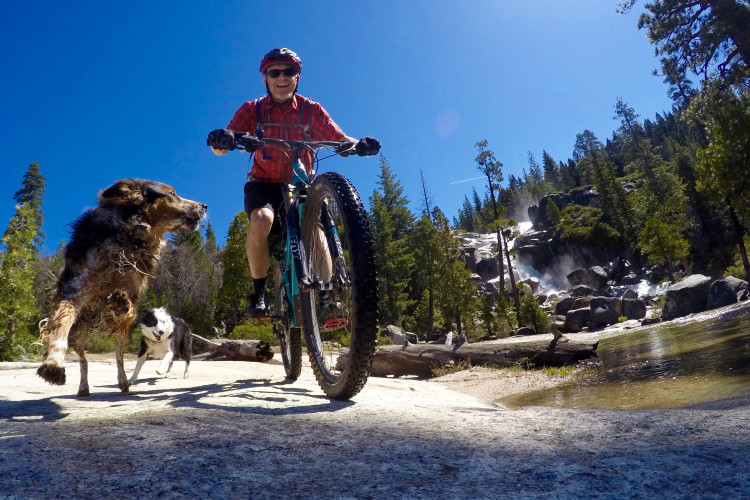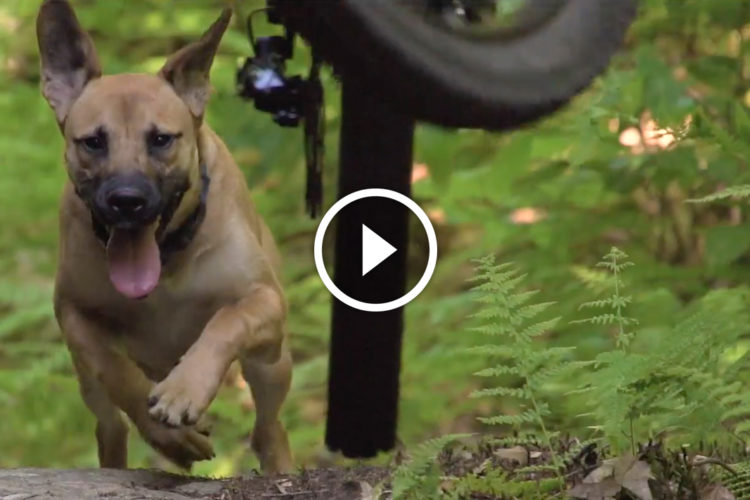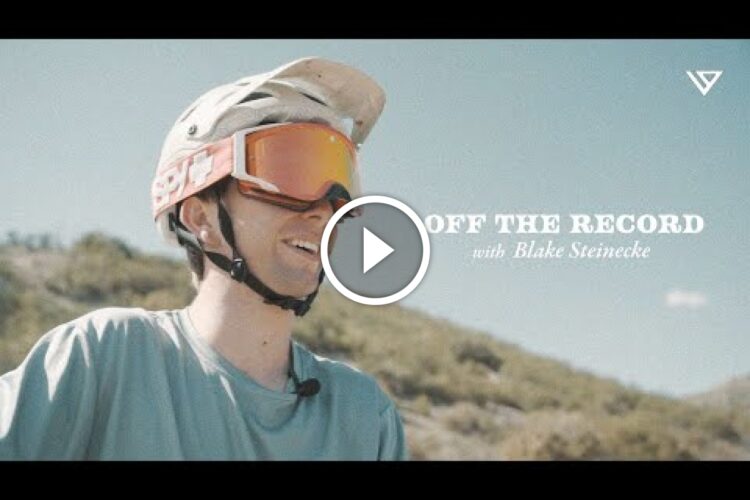Trail dogs are romanticized in the mountain bike world; by photos and videos, by our own existing relationships with dogs and our relationship with mountain biking. Seeing that rider on the trail, carefully picking his way through a line while the dog bounds over the steep ledge and snaps through a corner, chasing the rider’s rear wheel, is sure to bring a smile.
Dogs are seemingly the perfect riding companion. They ride at your speed, and gallup up steep climbs, without mulling over the best possible line. They are cuter than any other riding buddy out there. They don’t try and talk about work when you start descending. And mountain biking – or trail running from a dog’s perspective – has got to be one of the best times ever, if I’m inferring from the electricity I’ve seen from most dogs chasing mountain bikers. Yes, the allure of having a trail dog is real.
Three or four years ago, my now fiance began to plant seeds. They weren’t all that subtle. “I want a dog,” she would say. “When can we get a dog?” “Why don’t we have a dog?”
I grew up with dogs, but had only had a cat in my adult life. As a child, I didn’t bear responsibility for my dogs, other than putting food in their bowls and picking up poop in the backyard. Cats are easy, and compatible with the lifestyle of mountain biking. Want to go on a ride? Put your shoes on and leave. Your cat doesn’t give a shit what you do most of the time. Want to head to Moab for the weekend? Go for it. Leave enough food for a few days and expect some forceful affection afterward.
But after a heavy summer of riding, stacking on miles to prepare for a stage race, and stage racing, I was ready for a break. Our schedules would slow down in the fall, and we’d have time to raise a puppy, take them to training, and get the fundamentals down.
We looked at a few dogs online, but I was somewhat particular about the breed. The first dog we saw in person, we got – after an application and home visit by the adoption agency. I drove about an hour away to pick her up, and within the first hour of Maple being at our home, she had peed on the floor three times. There was no time to soak in her floppy ears and clumsy waddle. Training began immediately.
We knew there would be a learning curve, for the humans, the puppy, and for the cat of course. But we also knew that Maple would be an active pup, and eventually I wanted to take her out on the trails. Since she was a rescue, from somewhere down in New Mexico, we didn’t know her exact breed, but there was obviously some German Shepherd in her lineage. Our new dog trainer pointed out that she’s probably Belgian Malinois, rather.
The consensus on Malinois according to the internet? They are not good breeds for first time dog owners. Good to know. They need intensive training, mental stimulation, physical exercise, and a job. Yes, a learning curve indeed. On the flip side, they are intelligent, easy to train, and very affectionate. Since they were bred to be working and herding dogs, they have a high prey drive and chase instinct. And since she’s a working dog, she gets difficult if she doesn’t exercise. I know the feeling.

After we’d moved into a new neighborhood, I started to take her on leashed rides around the block. The first time, we were both a little nervous. I held her leash in my left hand, and held the handlebars with my right. After a few rides though, and a few darts across the path of my front tire, she got comfortable with her little pocket on my left side. With my left hand, I could pull on her leash and bring her closer to the bike, if a car were passing us. Eventually, we’d do our trips around the neighborhood almost every day in the summer.
My fiance, Hannah, took her on trail runs and she learned what it’s like to be on singletrack, and that she might see other people, and dogs, and a donkey once in a while. As recommended, we started with shorter durations of exercise early on and progressed to longer runs and rides. Even though she has the energy of a turbocharged Honda CRX, she tired out after four or five miles. We made sure to bring her snacks and water and give her breaks.
There’s a big difference in taking a dog out on a tethered trail experience, versus an off-leash ride. The busy, overgrazed trails close to our home, full of people with other dogs, where elk and deer roamed, and sometimes snakes are not an inviting environment to try it, nor is it legal. This spring though, as we were headed out toward the desert, the BLM-managed trails and sparser population posed a better opportunity to try an off-leash ride.
Maple knew her basic commands – sit, stay, come, leave it. She wasn’t perfect with them, but we also knew with her instincts to chase, that getting her to follow us shouldn’t be a problem. We also thought about how to get her attention, and how to hold it, so that if she did see wildlife, or another group needed to pass, then we could get her to sit, wait, and focus. So along with our water bottles, and spare tubes, we stuffed treats and a Chuck-it ball in our packs. Knowing her motivators was key.
I asked local riders ahead of our trip if off-leash dogs were kosher, and then people with dogs at the trailhead when we showed up. We picked a green-rated, 4-mile loop, unleashed Maple and Hannah and I sandwiched her, Hannah ahead with Maple in pursuit and myself in the rear. And just like that, we were off. There was no adjustment, or subsequent training – as long as we were moving, Maple was moving.
If one of us got ahead a little, Maple would stick with the leader, run back to check on whoever was behind, and then run back up to the point position. As we rode on, our nerves quelled. We were loving it, and so was Maple. We stopped worrying about her running off into the desert, her first home. I think she knew that for a dog, it doesn’t get much better than this. Once or twice, she ran up to lick a hiker’s hands, but fell back in formation.
Hannah and I switched, and I took the lead. A little faster, Maple’s legs scorched the trail behind me. She leaned around the corners and lept entire cattleguards. Slowing down to a jog, we cruised back to the trailhead. Maple raided another pup’s water bowl and we wrangled her back to our car, filled up her collapsible bowl and gave her a snack.
For a four-mile ride on a beginner loop, it might already be the highlight of our 2021 season. Usually, on our rides together, Maple’s in the back of our head. We need to get back in a reasonable amount of time to let her out, feed her, and then take her to the park. That four-mile loop for us was a reaffirmation that we have succeeded in some way with training, and sharing a mountain bike ride and the passion for hauling ass down a winding trail with our dog, only further defined our still fresh familial bond.
Riding with the dog won’t always be possible unfortunately but that makes the experience a little sweeter.





















2 Comments
Apr 16, 2021
May 3, 2021
Words rarely spoken in her presence are bike, mountainbike and a few others.
One process that took a little time... Learning to drink from a Camelbak 'ose! Hydration is ever more important on the trail due to the exertion and activity. So, the process began early.
abegold, thanks for sharing your trail dog experience too! They are family and indeed the best companions.
Matt, thank you for the article and the awesome dog shared with the masses.